Originally published in the Times Argus/Rutland Herald Weekend Magazine, October 1, 2021 for the “Remember When” column with the title, Apple of Vermont’s Eye
This roadside fruit stand was pictured near Bennington in 1939 (Library of Congress)
In September 1922, Bess M. Rowe penned an article for The Farmer’s Wife after she visited the Dimock Orchard Farm in East Corinth. In “Bringing Back the Old Trees,” Miss Rowe wrote of the charming conversations she had with the self-named “farmerettes” who, since taking charge while “the men” were away at war, continued to be instrumental to the farm’s successful operation. After Mr. and Mrs. Julian Dimock — a magazine writer and former professor, respectively, and farming novices both — moved to Vermont and started the farm 10 years earlier, they were proving themselves adept orchardists.
Their success could be put down to natural talent or, as Miss Rowe noted, their receptiveness to “modern ideas and methods,” and having “nothing to unlearn.” But the couple’s move into apple-growing also came at an opportune time in Vermont’s fledgling apple industry.
Continue reading


